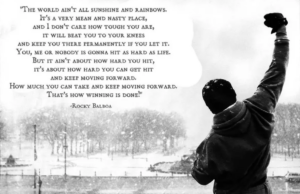
The Idea
Resiliency and Grit are learned behaviors that enable us to not only survive, but thrive in the face of adversity. This is your 9th of 14 daily messages, each containing an exercise designed to strengthen your development of these two key skills. Keep a journal, record your reflections and chronicle your growth.
Exercise #9
There’s a brutal truth that some people refuse to accept: You have no control over many of the things that happen in your life.
We often spend a great deal of time trying to control that, which in fact, is beyond our personal control; a spouse, child, friends, co-workers, the economy, etc.. While a certain level of influence and control may apply, in most cases the reality is we have very little control over how other people think, how they react, what they do, and how they behave.
The goal of today’s exercise is to become aware of factors that are within and beyond personal control. This awareness can prevent us from wasting precious energy in an attempt to control the uncontrollable, while simultaneously promoting the investment of energy into the things that are controllable.
Step 1: Create a four-column table. Use the following labels:
- Column 1: Desired Outcome
- Column 2 : Factors/Actions to achieve desired outcome
- Column 3: Factors/Actions I can control
- Column 4: Factors/Actions beyond my control
Step 2: Identifying a desired outcome – Take a moment to consider an important goal that you would like to achieve. Write down this goal in the first column of Table 1. Make sure to formulate the goal in a way that specifies a direction towards an outcome (e.g. I want to feel more relaxed), rather than in a way that specifies a direction away from an undesired outcome (e.g. I want to experiencing less stress).
Step 3: Identifying actions: Consider the goal you mentioned in Step 2. Think of actions that will help you get closer to your goal, and write them down in the second column.
Step 4: Identifying actions that are within personal control. Look at the actions you listed in Step 3 and determine which aspects of the action you have full control over. In other words, which aspects of the action do not rely on other people or on uncontrollable circumstances to follow through with them? List these aspects in the third column.
Step 5: Identifying factors that are outside personal control. Consider each of the actions you have full control over as listed in Step 4. Now, from an action perspective, think of all of the things you do not have full control. In other words, identify those things that lie beyond your power. List them in the fourth column.
Once you have completed your table, take a moment to reflect and ask yourself:
- What did I learn from this exercise?
- As I look at my desired outcome, what controllable factors would benefit from the expenditure of additional energy?
- As I look at my desired outcome, uncontrollable factors am I spending too much energy pursuing?
You can’t prevent a storm from coming, but you can prepare for it. You can’t control how someone else behaves, but you can control how you react. Recognize that, sometimes, all you can control is your effort and attitude. When you put your energy into the things you can control, you’ll be much more effective.
The next message will come out on Monday! Enjoy the weekend and don’t forget to
